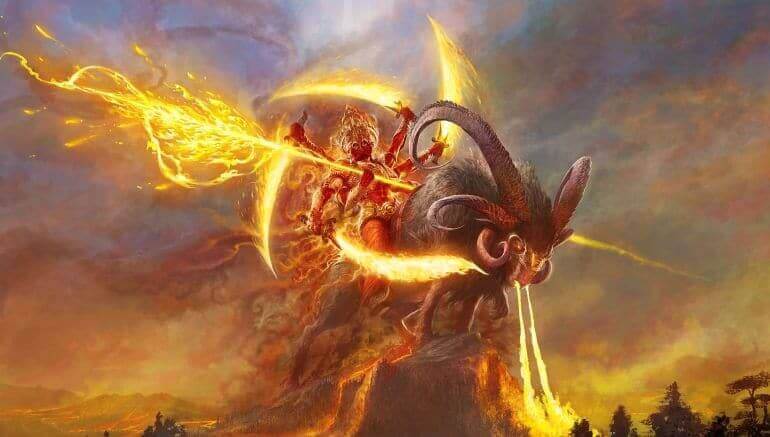Have you ever wondered about the mythological brutes who are believed to have was in Hindu tradition? creatures with corridor of other creatures, or humans with part of creatures or numerous further.
With superpowers similar as their bodies made of ice, fire, and dears or a mortal with the lower part of a fish. Or critter who can change its appearance freely and feed on mortal powers, a thousand- headed snake. Wanna know more? Keep reading for 11 of the mythological brutes according to Hinduism.
Makara
A Makara is an oceanic fabulous mythological beast. It’s a critter with the body of a fish, the box of an giant, the bases of a captain, the eyes of a monkey, the cognizance of a gormandizer, and the tail of a peacock.
Makara is the Vahana of Goddess Ganga and ocean God Varuna. It’s the hallmark of the affection of God Kamadeva. Makara is the visionary suggestion of Capricorn, one of the 12 images of the wheel.
The rainbow fish
The rainbow fish
The Rainbow Fish is an amazing beast in Hinduism as enormous as a Goliath which ate Vishnu’s incarnation. Or buddha who expelled passing the world.
When the rainbow fish was caught, it gave the country aliment for an entire time. Its red scales were made of dears, blue of ice, herbage of lawn and yellow of lightning.
Navagunjara
In the Hindu grand Mahabharata, Navagunjara is an beast made of nine distinct brutes. The critter is a typical theme in the Pata- Chitra style of oil, from the Indian fiefdom of Odisha. Also, the variant of the Mahabharata, composed by Oriya artist Sarala Dasa, portrays the legend of Navagunjara.
Navagunjara has the leader of a funk and stands on three bases – of giant, barracuda, deer, the fourth accessory being a raised mortal arm conveying a lotus or a wheel.
The mammoth has the neck of a peacock, the reverse of a bull, the waist of a captain, and the tail of a snake.
Sharabha
Sharabha is an beast in Hindu myth that’s a part captain and part flying critter. As indicated by Sanskrit jotting, Sharabha is an eight-lawful brute, puissant than a captain and giant and which can murder the captain.
Sharabha
Shaiva sacred textbooks portray that god Shiva accepted the symbol( incarnation) of Sharabha to constrain Narasimha – the wild man- captain symbol of Vishnu. In Buddhism, Sharabha shows up as a once birth of the Buddha.
Yaksha
The Yaksha is a class of nature- spirits who oversee characteristic fortunes covered up in the earth and tree roots. They show up in Hindu, Jain and Buddhist jotting.
The womanish type of the word is Yakshini. The yaksha has a double character. From one perspective, a yaksha might be an inoffensive nature- hobgoblin, related with forestland and mountains; yet there’s also a darker rendition of the yaksha, which is a kind of phantom that frequents the wild and waylays and eats up explorers.
Kamadhenu
Hindu sacred jottings give differing records of the preface of Kamadhenu. While some portray that she rose up out of the shifting of the grandiose ocean, others depict her as the little girl of the maker god Daksha, and as the partner of the savant Kashyapa.
Different sacred jottings portray that Kamadhenu was in the power of either Jamadagni or Vashista( both old pundits). Also that the lords who tried to take her from the savant brazened critical ramifications for their conditioning.
Kamadhenu
Aditi
Aditi is the wellspring of all prodigies in Indian myth. She guarantees to give a perpetual force of milk to all people counting on the prerequisite that people carry on as her calve and approach her with compliance as hurting her would hurt the Earth itself.
As the heavenly mama of each current structure and being, the union of all effects, she’s related to space( akasha) and with psychic converse. She might be viewed as ladylike Brahma and is related to the base substance in Vedanta.
Pishacha
Among numerous mythological brutes, Pishachas are towel eating evil aspects as per Hindu myth. As a matter of fact, their roots are dark although they’re believed to be made by Brahma. Also, another legend portrays them as the children of either Krodha( outrage) or of Daksha’s girl Pisaca.
Pichachas have the capability to accept colorful structures freely, and may likewise wind up undetectable. They feed on mortal powers.
Now and also, they’ve people and change their musings, and the exploited people are beset with an multifariousness of conditions and irregularities like madness. Certain mantras should fix similar worried people, and head out the Pishacha.
Pishacha
Pashupati
A transmission of god Shiva, Pashupati lives in the backwoods and the timbers and protects crowded brutes.
He was the person who brought expressions like music, plays, move and oil to people. He appears as any critter. Pashupati is the master of the backwoods spirits, the Vidyesvaras.
Shesha Naag
The thousand- headed snake in Indian myth, Shesha Naag, is also called Ananta. When it ringlets forward, creation happens, when he circles in rear, the macrocosm stops to live. Further, he was given the name ‘ Shesha ’ which means leftover as only he and no bone
differently remains.
previous to Balarama, Laxman, the stock of Rama, was likewise a incarnation of Shesha Naag It utilizes seven of its heads as a bed for Vishnu. He’s the first of the Naga lords and lived in Thiruvananthapuram.
Shesha Naag
Matsya
In point of data, Matsya is one of the mythological brutes that are a symbol of Vishnu as a fish. The Matsya is believed to be a monster fish analogous to a mortal with a mortal middle and the reverse of a fish.



